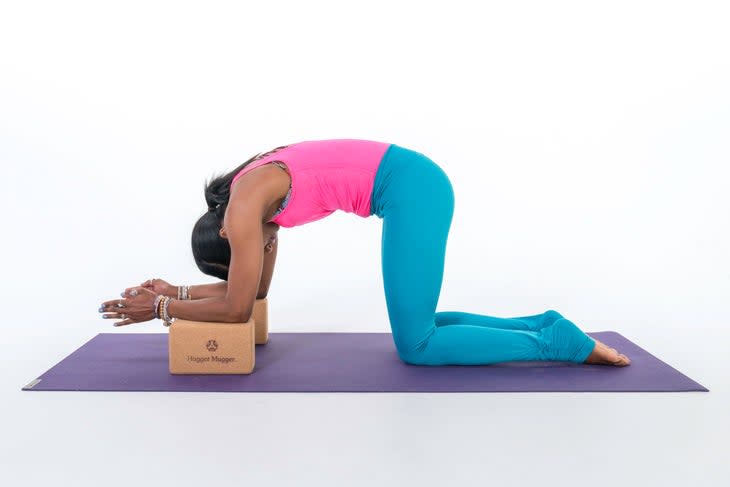Cat Pose
You will encounter Marjaryasana (Cat Pose) and its counter pose Cow Pose (Bitilasana) in many yoga classes. And for good reason: These poses help warm up the spine. Cat Pose can serve as a prep for forward bends and an expansive counter pose to inversions and backbends.
While in this pose, focus on tucking your tailbone, rounding your spine and releasing your neck, says yoga teacher Nicola Jane Hobbs, author of Yoga Gym and Thrive Through Yoga. Completely surrendering to this pose--and breathing through it--will make your body feel at ease.
Cat Pose basics
Sanskrit: Marjaryasana (Mar-jar-YAH-sun-ah)
Pose type: Backbend
Targets: Core
Why We Love It: “This pose is one of my absolute favorites because it sets the stage for many of the postures we encounter later on in a practice,” says YJ contributor Jenny Clise. “In its simplest form, it flexes our spine, stretches down the back, and strengthens our core. Cat Pose also offers an often overlooked tool: shoulder protraction. This is a major theme in our practice. When stepping to the top of our mat from Table or Downward-Facing Dog, we must protract our shoulders to make room for our foot to step through. When approaching arm balances like Crow or Crane Pose, or the alluring Handstand Press, it is not just our core that is working. Our shoulders need to be protracting like crazy! Whenever I face a roadblock in my practice, I think about what postures exist within the one I am trying to achieve--and then I return there. I cannot tell you how many times I have returned to Cat Pose.”
Become a member today to get access to Yoga Journal’s Pose Library, which blends expert insights from top teachers with video instruction, anatomy know-how, variations, and more for dozens of poses. It’s a resource you’ll return to again and again.
Pose benefits
Cat Pose warms up your spine, shoulders, and hips. It improves posture, and counteracts the effects of sitting and computer work.
Cat Pose: Step-by-step instructions

Begin Tabletop with your hips directly over your knees. Your hands should be shoulder-distance apart and slightly ahead of your shoulders. The wrist creases should be parallel to the front of the mat.
Press down firmly through your hands.
Exhale and round your spine toward the ceiling. Drop the crown of your head and your tailbone. Draw your lower belly in and up.
Push the floor away with your hands to broaden across your shoulder blades.
Keep the hips over your knees and your arms straight to keep the movement in your spine.
To release the pose, return to a neutral spine.
Beginner’s tip
Let your head drop naturally by releasing the back of your neck; don’t force your chin to your chest. Keep your shoulders relaxed and away from your ears.
Teaching Marjaryasana
These cues will help protect your students from injury and help them have the best experience of the pose:
Initiate movement from your spine and hips, not your arms.
If this pose hurts your knees, place a blanket under them for padding.
Variation: Cat Pose with blocks
If you have pain in your wrists or hands, bring your forearms to blocks. If you don't have blocks, you can bring your forearms to the floor.
Preparatory poses
Tabletop
Counter poses
Uttana Shisosana (Extended Puppy Pose)


